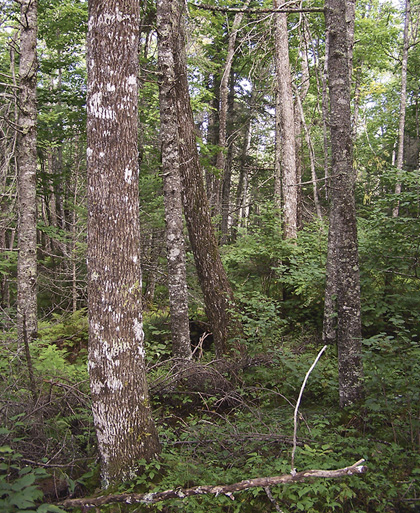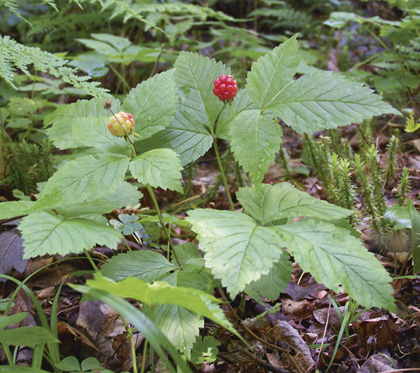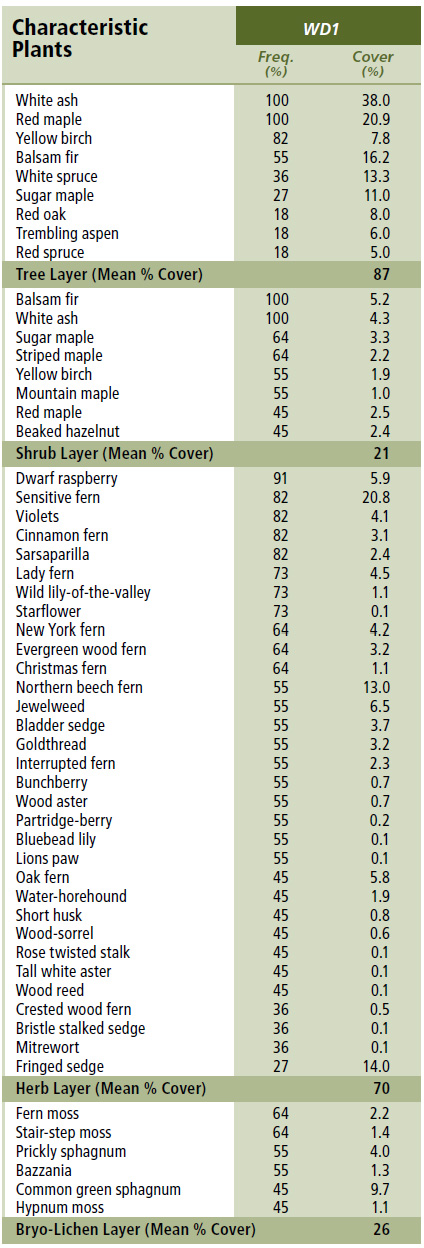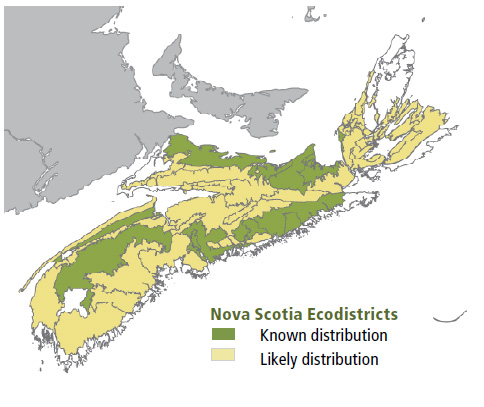
Forest Vegetation types - WD1
WD1 —White ash / Sensitive fern – Christmas fern
Fraxinus americana / Onoclea sensibilis – Polystichum acrostichoides
 |
| Angevine Lake, Cumberland County |
Concept: White ash / Sensitive fern - Christmas fern forest is characterized by prominent white ash and a species-rich herbaceous understory. It is typically found on imperfectly to poorly drained mineral deposits with high nutrient availability, and is one of the richest wet forests in the province.
Vegetation: The well-developed canopy is co-dominated by white ash and red maple, but the latter species occurs with lower cover. Yellow birch and sugar maple are also frequent but seldom abundant and often restricted to the understory. Some stands support moderate to high balsam fir in the overstory, but these stands are uncommon. Black ash has also been recorded as an infrequent and minor component of stand structure. Shrub cover and species richness is reduced. The herbaceous layer is well developed and diverse, frequently including sensitive fern, lady fern, dwarf raspberry, New York fern and Christmas fern, among other species. Bryophyte development is low to moderate, composed of small pockets of upland species and nutrient demanding wetland mosses (e.g. prickly sphagnum).
Environmental Setting: This is primarily a wet forest although it may develop on moist sites. Ground and surface water flow and/or seepage contribute to high moisture and nutrient input. Both mineral and organic soils can be found, but fine to medium textured mineral substrates are most common. It occurs at very low elevation on flats and lower topographic positions of gentle slopes, in shallow depressions, and adjacent to streams and other water bodies. Surface microtopography and exposed bedrock are typically low. Organic matter accumulation is low to moderate. WD1 is rare on Prince Edward Island and unreported from New Brunswick.
Successional Dynamics: The ecosystem is a type of edaphic climax and is expected to persist as described. Stand composition and structure are usually maintained by small- to intermediate-sized disturbance events and limiting site conditions. Due to its ecological setting, WD1 does not shift to other vegetation types after disturbance, but it does change in development stage. Red maple cover can also fluctuate over time. Excluding harvesting, stand-level disturbance events are rare, with gaps or small patches usually created by individual tree mortality through senescence, wind or ice scour.
Ecological Features:The White ash / Sensitive fern – Christmas fern is a productive ecosystem, with high species richness, complex stand structures, and a broad diversity of habitat values. This mature small patch forest is characterized by temperate tree and herbaceous species (e.g. white ash, Christmas fern). Documented rare plants include black ash, but numerous other species may be supported. In spring and early summer, sites are inundated with water, most of which is concentrated in small pools or channels, providing habitat for amphibians and other wildlife. Later in the growing season, surface and ground water levels fall below the rooting zone. Old growth potential is moderate but may be higher in sheltered areas, or on drier soils.
 |
| Dwarf raspberry |
Distinguishing Features: This is a poorly drained hardwood forest dominated by white ash with lesser levels of red maple. The herb layer is well developed and diverse, often dominated by high fern cover including sensitive fern, lady fern, New York fern and Christmas fern.
| Slope Position: | Level8 Lower2 |
Surface Stoniness: |
(Non - Slightly)7 (Very - Excessively)2 nd1 |
Bedrock Outcrop: |
(Non-rocky)10 |
Elevation Range: |
24 - 199m |
Slope Gradient: |
Level7 Gentle3 |
Aspect: |
North1 East1 West2 None6 |
Exposure: |
Moderate6 Mod. sheltered4 |
Microtopography: |
Level5 Slightly4 Moderately1 |
Drainage: |
Imperfect4 Poor4 Very poor2 |
Soil Type: |
ST93 ST103 ST132 ST121 ST141 |
Parent Material: |
Glacial till5 Alluvium2 Lacustrine2 Organic1 |
Rooting Depth (cm): |
(<30)3 (30-45)5 nd2 |
Duff Thickness (cm): |
(0-5)3 (6-10)3 (11-20)2 (21-40)1 nd1 |

